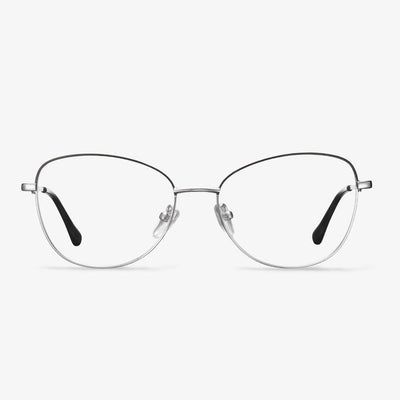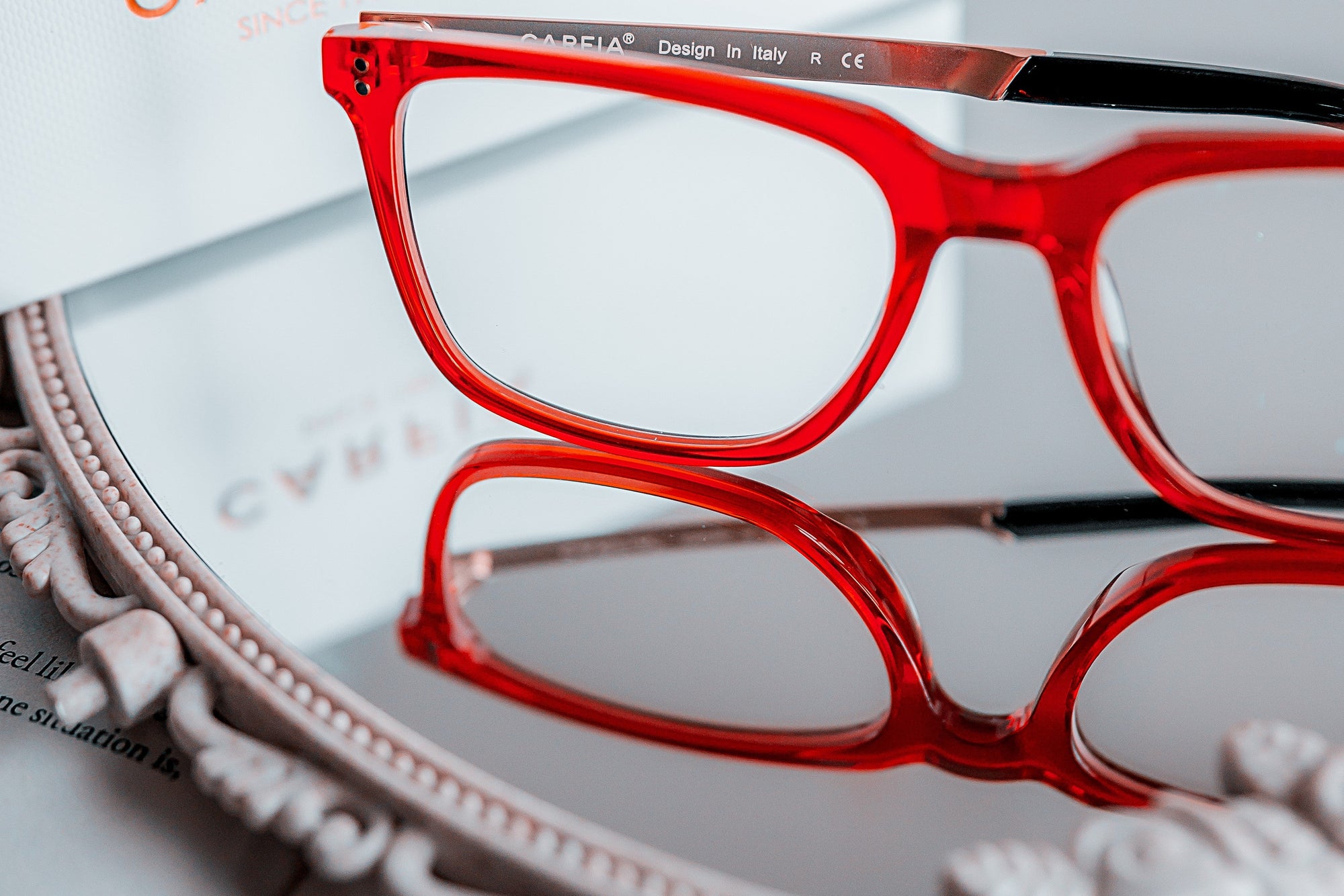Women's glasses are increasingly fashionable.
As for the color, there are a variety of metallic colors, unreal colors, transparent or translucent tones. The frame design is gorgeous and dazzling. There is an implicit low-key style with the brand logo embedded in the frame. Many models combine two or more materials, such as metals and plastics, in a unique way. There are both very bright colors and natural hues, with a wide selection.
History of browline frames
Shuron, an American eyewear brand with a history of more than 100 years, is generally considered to be the creator of browline frames. Browline glasses were very popular in the United States in the 1950s and 1960s. By the 1960s, as the shapes, sizes, and colors of plastic glasses increased, the popularity of browline frames gradually declined. In the 1970s, the hippie subculture led to a rapid decline in the popularity of eyebrows, which was considered conservative.(https://www.koalaeye.com/collections/browline-eyeglasses)
Until the 1980s, Bruce Willis wore tinted lenses in the Moonlight series, and the demand for browline sunglasses surged. In response, Ray-Ban launched Clubmaster, a traditional browline frame with sunglasses lenses. However, in the 1990s, browlines were strongly opposed by consumer culture. They are also regarded as too nerdy and conservative. Until the 2010s, the influence of the TV series Mad Men and the fashionable subculture inspired people to fall in love with the classic retro style of browline frames again.
Nowadays, with the progress of the times, there are more diversified choices in the material of the upper edge of the browline frames. On the whole, although the eyebrow frame is a bit serious, it has a calm and full nostalgic appearance, which is still the style that modern male gentlemen can't put down.
How Does Photophobia Glasses Work?
The visible light spectrum is made up of all the colors in the rainbow. Red light waves sit to the left; as you move to the right, there is orange, yellow, green, blue. And violet light, with other colors in between. The light resides along the visible light spectrum according to how long their wavelengths of energy are. UV light has the shortest wavelength and red has the longest.
However, UV light carries a significant amount of energy that can damage and burn our eyes. So, the indoor sunglasses for light sensitivity are designed to filter out and block blue-green wavelengths, fluorescent light, LED lighting, bright sunlight and other reflective lights that may affect the eyes.
After wearing photophobia glasses, the number of migraines may be reduced besides the eye damage. So, not only can they protect your eyes from the sunlight, but also can relieve other symptoms.
Hence, if you need a pair of light sensitivity glasses, Koalaeye glasses are recommended. They come in stylish and at a cheap price.
Best Eyeglasses For Women - Seiko glasses
Seiko frame pursues the perfect combination of elegant fashion and high-tech, providing people with excellent quality, fashionable style, and high comfort products. Seiko pure titanium eyeglass frame is the most noteworthy, and it is very rigorous in the selection of materials, high hardness, good quality. Women's spectacle frames adopt the world's popular carved design, making glasses practical and beautiful already.No matter you are engaged in what kind of occupation, they can highlight your noble temperament. They make the wearer feel comfortable, and at the same time, let each wearer can send out a distinctive temperament and taste.
What to consider when buying eyeglasses?
Usually, people with lighter skin tones choose lighter color frames, while those with darker skin tones choose dark color frames. For example, people with lighter skin tones can choose soft pink frames, tortoiseshell frames, or gold and silver frames, while those with darker skin tones can choose red, black, or tortoiseshell frames.
Do night driving glasses really work?
Yellow lenses reduce the amount of light entering your eye, reducing visibility. These darker colors block more blue light than yellow lenses. But they block more light from entering the eye, reducing visibility even more in low-light conditions. In fact, even yellow lenses reduce overall visible light to some extent because they block some blue light. This can be a good thing during the day, but not at night, when maximum visibility is key. Night driving glasses come in a variety of yellow and amber colors. The darkest lenses filter out the harshest light, but they filter out the largest amount of light, making it difficult to see in dim or dark conditions. Some people who wear night driving glasses say they can see better with them on. However, vision tests have shown that night driving glasses do not improve night vision, nor do they help drivers see pedestrians any faster than they would without glasses.
The design evolution of progressive lenses
Spherical and aspheric designs
The design of the front surface of the far-use area of the early progressive lens is similar to that of the ordinary spherical single vision lenses, so it is called a spherical progressive lens. Since 1974, the front surface of the far-use region of the lens is designed to be aspheric by designers, which not only reduces the peripheral aberration but makes the lens thinner, lighter, and less powerful.
Hard and soft design
For hard design, the channel is short, and the gradient is large. The near-use area position is high. The effective visual area of remote and near-use areas was larger. Peripheral astigmatism is relatively concentrated. Because surrounding astigmatism increases rapidly and the distribution is dense, the curve effect is more obvious. The gradient area is narrow. It is more difficult and takes longer for wearers to adapt.
Lenses with soft designs have slower gradients, longer gradients, and wider gradients. The angle of rotation of the eye from the far area to the near area is greater. It's easier to get used to. Compared with the hard design, the effective visual area of the far and near use areas is smaller, and the location of the near use area is lower.
Single, diverse, and individualized design
Initially, the progressive lenses used a single design, in which each basic curve was scaled equally and a luminosity combination was added within the range of its semi-finished lens blanks. The steepest base curve uses the same lens design as the flattest base curve. Lenses designers quickly realized that the overall performance of the lens could be improved by microcustomizing the lens design, leading to progressive lenses with multiple designs. This kind of design is called diverse design. By the mid-1990s, there was the emergence of individualized lens designs. In addition to using different gradients, these first individualized lens designs used steeper baseline curves with a slightly larger approach area to compensate for increased magnification and reduced field of view.
Symmetrical and asymmetric design
There is no difference between the left and right eyes in the symmetrical design of progressive lenses. As the eyes turn inward when they see near objects, the gradual gradient area gradually tilts to the nasal side from top to bottom, so the left/right progressive lenses should be rotated clockwise/counterclockwise respectively during processing. An asymptotic lens with left and right eye divisions is called an asymmetric design. The gradient is gradually and moderately inclined to the nasal side from top to bottom. The refractive force, astigmatism, and vertical prism of the two sides of the left and right gradient of the asymmetric design lenses are basically similar. At the same time, considering the characteristics of eye movement parameters in binocular vision, the peripheral aberrations of the corresponding positions of the left and right lenses were appropriately balanced to improve the visual effect of the wearer.











































